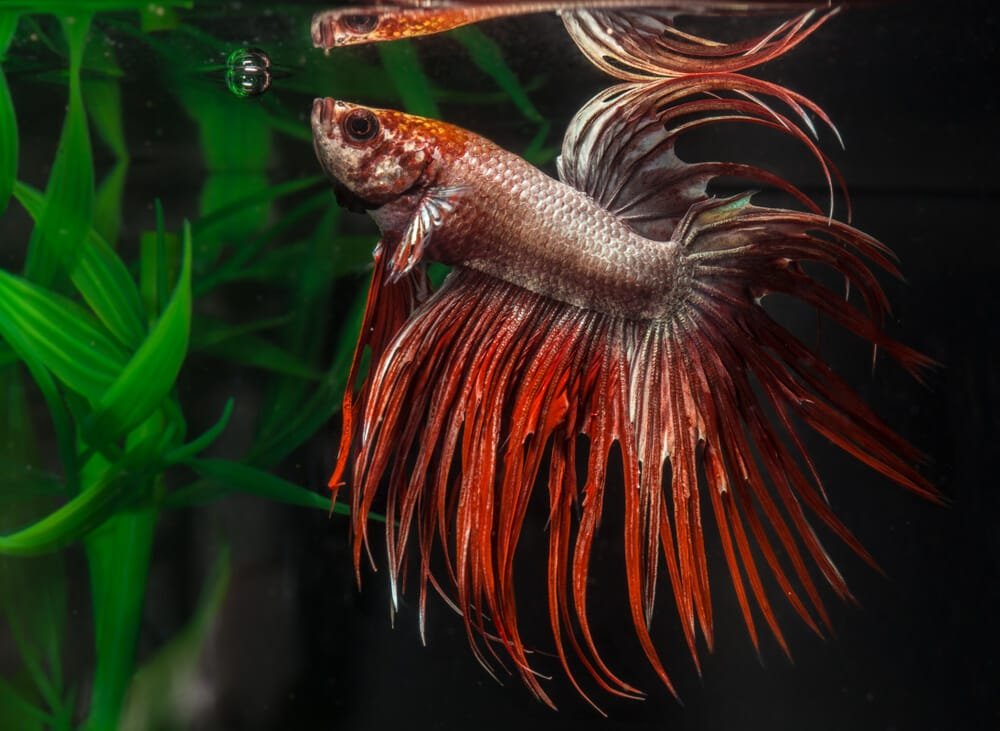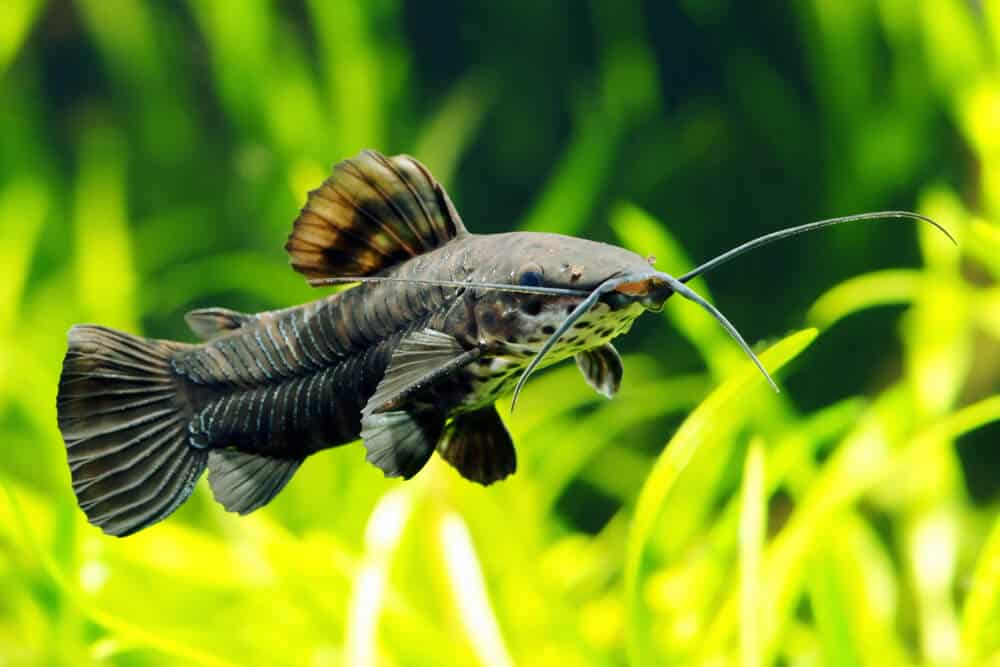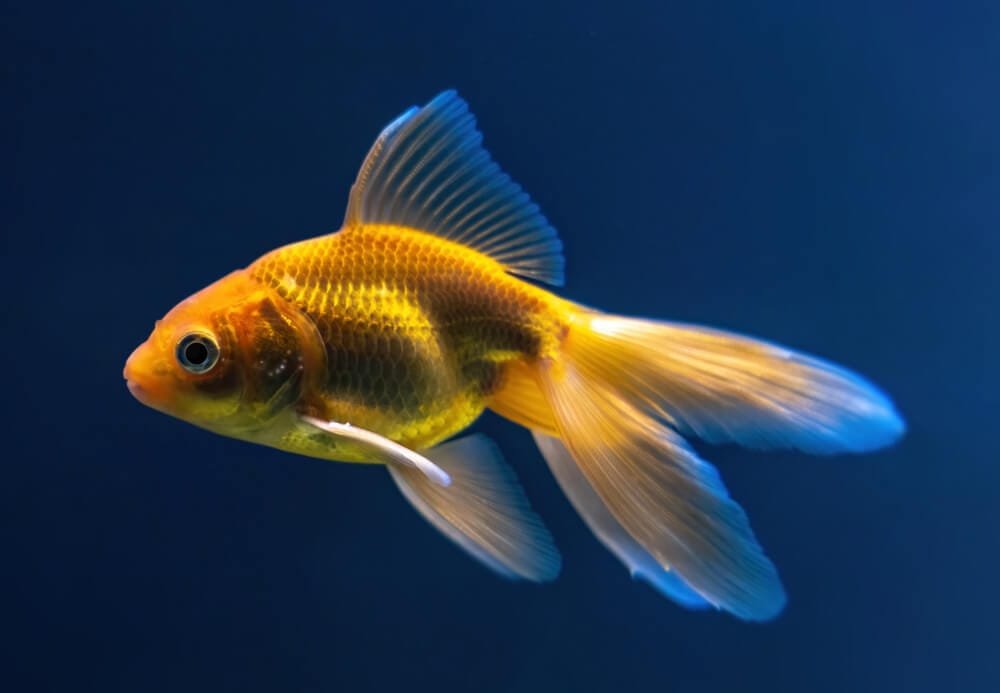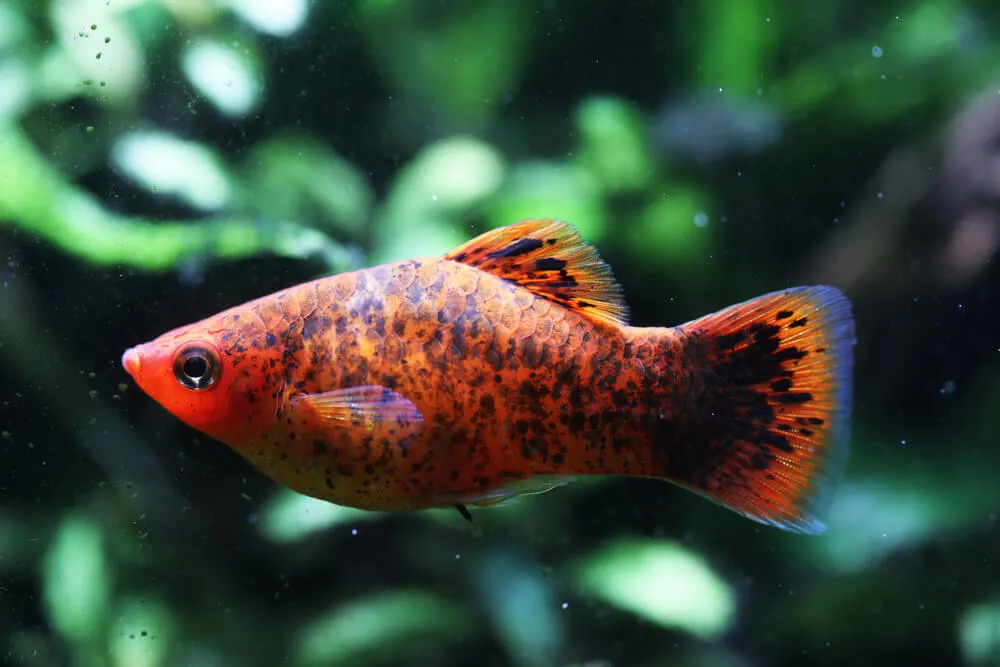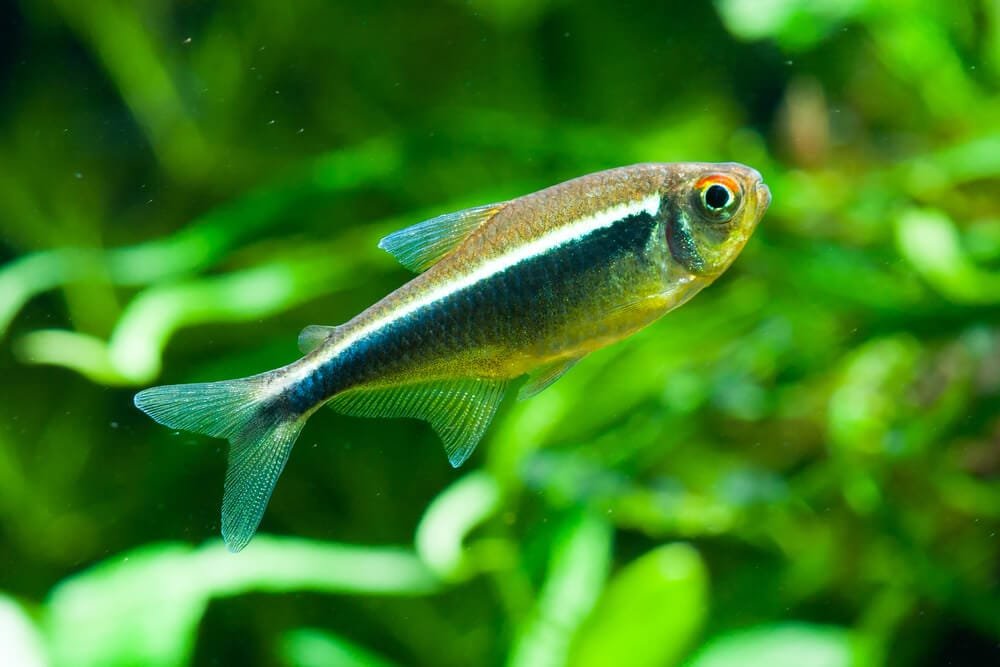Peacock Cichlid Care Guide 101: Types, Tank Setup And Tank Mates
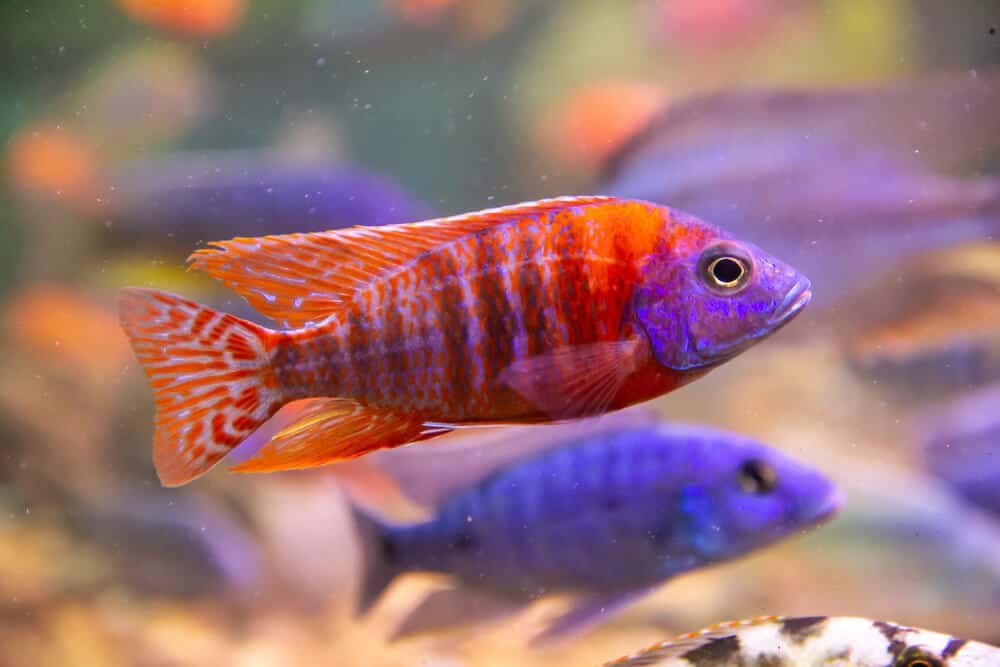
Peacock Cichlids are one of the most fun-looking fishes you can add to your aquarium. It’s one of the favorites among aquarists. If you’ve been contemplating adding them to your aquarium, we created this guide to help you get everything you need.
We’ll cover the basics such as what they are, what environment they need, as well as the perfect Peacock Cichlid tank mates.
What Is A Peacock Cichlid?
Peacock Cichlid comes from the cichlid species from the family of Cichlidae in the order Cichliformes in the Aulonocara Genus. Many varieties of Cichlids are mostly aquarium fishes.
They are freshwater fishes commonly found in the South American tropics, mainland Africa, Madagascar, and Southern Asia. From this family of fishes comes the Peacock Cichlid, one of the most popular freshwater fish among aquarium hobbyists worldwide.
Peacock Cichlid or otherwise known as aulonocara, is endemic to Lake Malawi in eastern Africa. If you’re not familiar, Lake Malawi is in the top 4 among the largest lakes in the world.
It is believed to have existed 10 million years ago. The aquatic creatures from this area had many years to evolve.
The Peacock Cichlids come in at least 22 different varieties, and most of them are spectacularly attractive. Their types have uniquely beautiful shades that stand out among the rest of the aquarium fish varieties.
No wonder they are famous among fish keepers. Their colors vary depending on which area in Lake Malawi they came from. Their most distinguishing colors are blue, red, and yellow, with a combination of other colors.
Types Of Peacock Cichlids
Since we cannot cover all the 22 varieties of the Peacock Cichlid clan, we will give you the most popular among them.
Red Peacock Cichlid (Aulonocara Stuartgranti)

The red peacock cichlid is also called the flavescent peacock. Peacock cichlid enthusiasts call this breed Grant’s peacock named after Stuart Grant, a known cichlid importer.
This type grows at about 5 inches long. Its striking fire red with shimmering splotches of electric blue makes it one of the top choices of fish keepers.
It is interesting to note that this type is a result of manmade breeding. That is why you may also find some variations of color, as most of them result from breeding two different species.
Yellow Peacock Cichlid

It is most popularly known as a sunshine peacock. This species possesses a spectacular bright yellow color with patches of iridescent blue.
The male sunshine peacock cichlid is more attractive than the female ones.
OB Peacock Cichlid

It’s considered one of the most impressive breeds. And it’s not only because of their physical appearance but because they are hybrid. OB peacock cichlids are crossbreeds between other peacock varieties.
Blue Peacock Cichlid

This variety of peacock cichlid is also known as emperor cichlid. It is one of the most favorite among peacock cichlid collectors. The male kind has a more striking bold and sometimes electric blue color, and the dark stripes on the sides make them even more attractive.
They become even more dazzling during the breeding season. The blue peacock cichlid can grow up to 7 inches long.
Strawberry Peacock Cichlid

This brightly attractive breed of peacock cichlid is not commonly found in the aquarium trade. The strawberry peacock’s beautifully colored body makes them a good addition if your purpose is to flaunt a stunning aquarium set.
This breed comes from the Southern part of Lake Malawi. They are semi-aggressive and omnivore. For breeding purposes, the recommended ratio would be 3 to 5 females for every male.
Despite their rarity, they are effortless to care. Just provide the appropriate level of salt and trace elements to their living space.
Dragon Blood Peacock Cichlid

The dragon blood peacock cichlid is a variety of hybrid species. They are a product of various successful combinations of Lake Malawi peacock cichlids. When fully grown, they reach a length of 7 inches and have a lifespan of over ten years with proper care.
Since this type of peacock cichlid is generally passive and peaceful, they are recommended to have aquarium mates of the same temperament and behavior. Their aquarium could be blackworms, spirulina flakes, shrimps, and cichlid pellets.

Are Cichlids Good For Beginners?
Peacock cichlid is recommended for beginners because they are one of the easiest to care for. Their bright and attractive colors are irresistible, thus making them the aquarists’ favorite. So, go ahead create a beautiful community of peacock cichlids.
What Is The Most Colorful Cichlid?
By reading the above types of cichlids, you can vote which you think is the most colorful among them. Peacock cichlid is topping the list as the most colorful cichlid varieties are found in Lake Malawi.
They are very famous for a vibrantly unique assortment of colors that range from iridescent red to electrifying blue to sparkling yellow and other shimmering shades and combinations of hues.
No wonder the peacock variety is the top pick of aquarists around the world. One of the favorites among the peacock variety is the strawberry type which flaunts its enticingly pretty color.
What Is The Most Peaceful Cichlid?
Although cichlids are known for being hostile in general, the Peacock Cichlid types are peaceful and calm. They are one of the friendliest varieties in the aqua world. However, the male peacock cichlids tend to become aggressive because of their territorial behavior.
What Is The Easiest Cichlid To Keep?
Generally, cichlids species are easy to keep, but it can be confusing to identify all of them due to their extended family. Cichlids come in different sizes, types, and varieties.
To make your search easier, we narrowed the list to the most desirable to keep among them. They are African cichlids, angelfish, Oscars, kribensis, and convicts.
1. Oscar

Among the list of the easiest to care Cichlid, Oscar is topping the list. Maybe it is because, in almost all Chinese restaurants and public places with an aquarium, you can have Oscars in them.
Although Oscar requires a large tank of up to 200 gallons, maintaining water quality is ironically a lot easier.
The good thing about it is that it eats almost everything. What is interesting about Oscars is that they are heavy breeders.
You need a larger tank because when they breed, they produce up to a thousand baby Oscars. Although Oscars come in many colors, their most distinctive color is red.
2. Angelfish

Angelfish have their own set of fans. This breed is uniquely attractive. Aside from its trademark color, angelfish also comes in different colors and fin designs. Feeding angelfish be a problem because they almost everything.
They thrive in most water conditions as well as in the company of other fish.
Angelfish can survive in community aquariums provided they are not kept with aggressive and bigger fish. On the other hand, smaller fish are also in danger of keeping together with angelfish as they tend to eat them.
3. Kribensis

Kribensis is smaller breed of cichlid. So, if you are looking for small fish, you won’t go wrong with Kribensis. Aside from its very attractive appearance and stunning colors, this breed is very undemanding.
They just love to chill around with their small groups and spend much of their time busy roaming around your aquarium decorations.
However, if you plan to breed, you can opt for other similar varieties since kribensis are hard to breed. Kribensis only breed in soft water, and creating a natural breeding condition for Kribensis is quite challenging.
4. African Cichlids

African cichlids consist of assorted varieties that are closely related to each other and have common characteristics. When you visit a fish store, you can find them grouped in one tank.
This bunch of fish is one of the toughest. They thrive in hard and alkaline water, which can easily be replicated in an aquarium. A consistent 70 to 80 degrees Fahrenheit water temperature will allow them to live well.
As for their eating habits, just like peacock cichlids, they eat almost everything. But give them a treat of raw fish once in a while.
5. Convict Cichlids

Convict Cichlids are also known as zebra cichlid because of their stripe patterns. Perhaps their patterns are the reason why they are called convicts.
But don’t worry, they are not fresh out of jail. The distinguishing characteristics of this type of species are their 8 or 9 black vertical bars on a blue-gray body.
Unlike other fish, the females have more black bands across the body. They reach a maximum of almost 5 inches when fully grown.
True to their name, the Convict Cichlids variety are notoriously aggressive and territorial, especially when breeding.
They demonstrate the unusual variation of behavior that makes them the favorite subject of studies. Aside from their aggressive behavior, they are generally very easy to care for.

Tank Setup
Aquarium
A full-blown Peacock cichlid can grow up to 7 inches. Thus it requires a spacious aquarium. The minimum tank requirement for these species is 55 gallons of fresh water.
Since peacock cichlids are bottom dwellers, their living space should have driftwood or makeup caves where they can have their hiding place.
The lake where peacock cichlids come from the water is known for its alkaline quality. To ensure that your peacock cichlid maintains its health, you must mimic the natural environment where it lives.
Their natural habitat is characterized by sandy substrate and rocks as they like to sift through the substrate.
It is important to note that these types of fish are active swimmers and substrate dwellers, so if you have plants inside your aquarium, expect them to mess around with your plants and even uproot them.
Water Condition
To mimic lake water, your tank should have a 76-82 degrees Fahrenheit water temperature. The pH level should be maintained at 7.8 to 8.6. Make sure that these pH levels and temperatures remain consistent.
To maintain water chemistry, do not feed them with sizeable single feeding a day. It is suggested to feed them small portions throughout the day.
Tank Mates
Whether you plan to keep more than one Peacock cichlids or a community of fish, it is highly recommended to get a 100-gallon capacity fish tank. If you are keeping other fish together with peacock cichlids, choose those varieties that also come from Lake Malawi.
In this case, you will not have to worry about the differences in their needs and environmental requirements. However, not all fish native of Lake Malawi can be put together with your peacock cichlids.
Some of these fish that should be avoided are tetras, rasboras tilapia, Mbuna, and Pseudotopheus. Also, it is not advisable to put together many species of Aulonocara in one tank as they tend to crossbreed.
This will lead to hybrid species, which lead to birth defects.
Some of the perfect housemates for your peacock cichlids are as follows:
1. Nyassachromis: A streamlined kind that comes in plainer color with striped patterns.
2. Otopharynx lithobates: Also known as the sulfur-headed hap. This kind is generally peaceful. It has yellow dorsal and blue underbelly color.

3. Copadichromis: This variety comes in different colors and can grow as long as 8 inches. It is relatively a friendly kind.

4. Placidochromis: It flaunts a stunning marble-blue scale. It closely resembles the characteristics of the peacock kind because they also live in the sandy region of the lake.

So as not to create rivalry and competition in your aquarium, it is best to maintain a ratio of 1 male to 4 females. Take note the male peacock cichlids are territorial. Having this ratio will prevent the male from becoming aggressive.
This is also the reason why you should have a makeshift cave in your aquarium because, during mating season, the male peacock cichlid lures the female into its cave.
Can You Mix Peacock Cichlids With African Cichlids?
There are African cichlids that are known for their aggressive behaviors, such as tetras, rasboras tilapia, Mbuna, and Pseudotopheus.
But generally, since peacock cichlids and some African cichlids come from the same natural habitat in Lake Malawi on the east coast of Africa, they do well together.
Can Angelfish Live With Peacock Cichlids?
Since angelfish come from South America and peacock cichlid from Africa, they have their differences. Angelfish tend to be more docile than their African counterpart.
Since they come from different environments, they have different care needs. Angelfish temperament is peaceful and known to keep a small school.
They tend to be more territorial as they mature. Keeping African cichlids and angelfish together is not a good idea.
However, in the case of peacock cichlids, they might get along well because both of them are of a peaceful kind. Although angelfish and peacock cichlids have differences, these differences are tolerable.

Care Guide
To provide excellent care for this kind of species, you must know the basic information about them.
Here is the summary of what you need to know when taking care of the Peacock cichlid.
| Minimum Tank Size: | 55 gallons |
| Temperature: | 75 – 85 degrees Fahrenheit |
| Diet: | Omnivore |
| Size: | 4 to 6 inches |
| Lifespan: | 6 to 8 years |
| Genus: | Aulonocara |
| Behavior: | Extremely active, love to sift through the sand, hide in bottom caves and rock crevices, and uproot plants. |
| Preferred Dwelling: | Bottom dweller of up to 10 meters from the surface when in a natural setting. |
| House Mates’ Preference: | Not so much selective, can tolerate other species as long as they come from the same lake, but there are just a few exceptions. |
| Breeding Ratio: | 3 to 5 females for every male |
| Ideal Community Tank: | As many as you want as long as the tank can support. It is best to keep 2 females for every one male. |
Although there are different types of peacock cichlids, they have more or less similar characteristics and needs. Having learned about their essential features, you can give them the necessary care and living space required for their survival.
Common Diseases
Although peacock cichlids are very easy to care for, they are not immune to aquarium diseases. Any aquarium fish can be exposed to pathogens, and at some point, they will get sick.
There are various freshwater aquarium fish diseases, and cichlids are identified as susceptible to a few of these diseases. You must watch out for the following:
1. Malawi Bloat
This is the most common disease among African cichlids. The symptoms of this disease are discolored feces, rapid breathing, loss of appetite, and abdomen swelling.
When they loll at the bottom of the tank for an unusually more extended period, you must be alarmed.
When this disease leads to liver and kidney damage, it could be fatal. There is no definitive known cause of Malawi Bloat.
Some say that they are caused by protozoans that live in the intestines of the cichlids.
2. Cotton Wool Disease
When you see a fuzzy white growth on the head, fins, and scales, your cichlids must be infected with the cotton wool disease. It is caused by a fungus that is commonly found in fish tanks.
The fungus only grows in the presence of poor water quality. Uneaten fish feeds and other organic matters that accumulate in the bottom of the aquarium may result in low water quality.
Aside from the fungus, stress and injury may also cause them to acquire the cotton wool disease. To treat this disease, use antifungal medication. Preventing this disease is easy, just maintain your water quality and keep your cichlids from being stressed.
3. Gill Flukes
Gill flukes come from parasitic flatworms that infect the gill of the fish. The flatworms attack the gill membranes causing them to become reddish and develop a thick slimy coat. This thick slime will prevent the fish from breathing.
So, when you see your cichlid gasping for breath or rubbing its body against objects in the aquarium, it may be showing a symptom of gill fluke disease. To treat this disease, add one tablespoon of salt to the tank and slightly increase the tank’s temperature.
4. Swim Bladder Disease
The swim bladder disease attacks the abdominal sac of the fish that helps them stay afloat. Fishes that are affected by this disease have difficulty staying submerged. Some causes of this disease are external trauma and physical injuries.
It can also be caused by underlying conditions such as cancer and tuberculosis. But the most common cause of this disease is poor diet or constipation.
To treat this disease, you must find out the underlying causes to give the necessary treatment. AS for poor nutrition, feed the fish with a variety of high-fiber foods.
5. Tuberculosis
Yes, fish can also acquire diseases such as tuberculosis. It is highly contagious and fatal. Interestingly, this disease can be transmitted to humans through contact with open wounds or sores.
The symptoms of this disease are loss of appetite, sunken stomach, white blotches on the skin, and frayed fins. This disease is also manifested through behavioral changes such as listlessness and lethargy.
When suspecting that your fish exhibits these kinds of symptoms and behavior changes, immediately transfer all the fishes in the hospital tank and treat the water with melafix. Then thoroughly clean the original tank by disinfesting all the objects in the tank.
Diet
Since peacock cichlids are omnivorous, they eat both meat and plants. In the natural setting, they stay at the bottom of the lake to look for food.
Although they are omnivores, it is recommended to give them more meaty food. The good thing about the peacock cichlids is that they are not picky eaters. Choose food that sinks as they tend to stay in the bottom of the fish tank.
Size
Depending on the type, peacock cichlid’s size range from 4 inches to seven inches. This is the reason why they require a spacious tank.
Final Words
Now that you have an overview of Peacock cichlids and how to take care of them, you can finally start adding them to your tank. Just keep in mind what they need, and they’ll surely thrive in your aquarium.
We hope we helped you understand everything you need to know about this eye-catching species.

